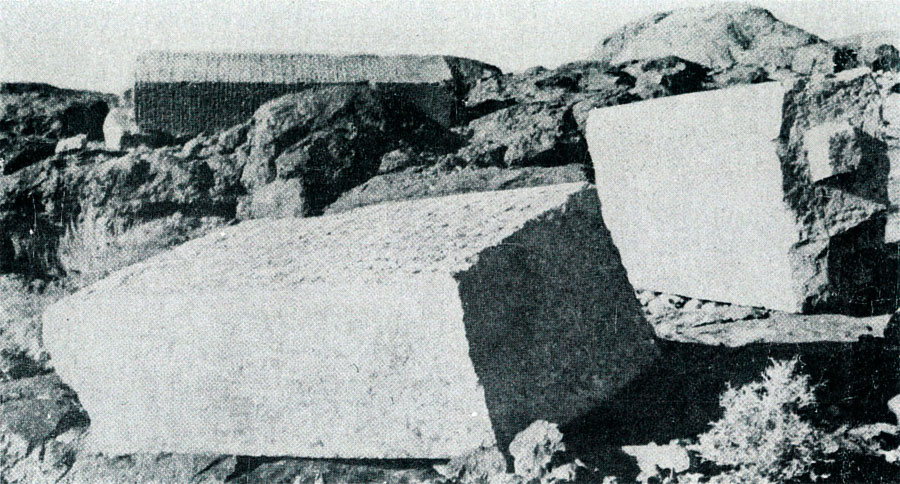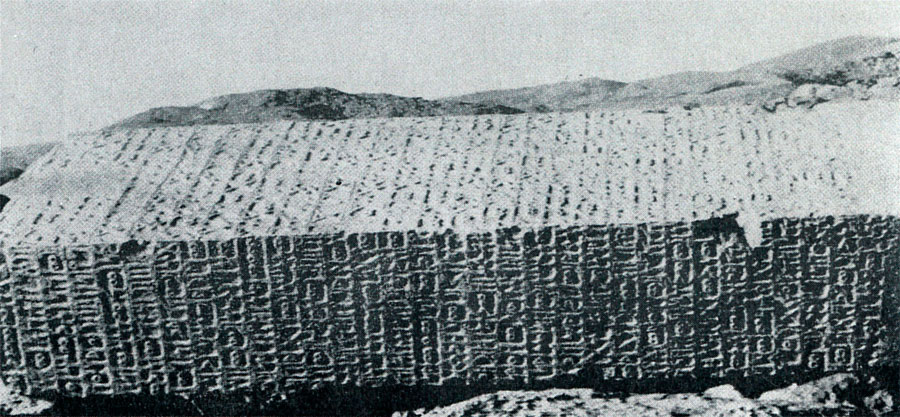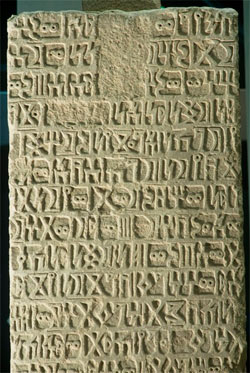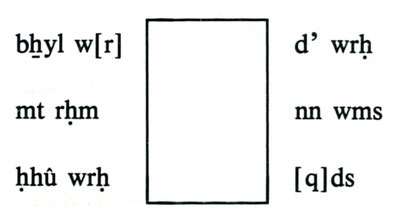THE MĀRIB DAM STELAE
The stele of Šaraḥbiʾil Yaʿfur (Vth century)
The stele of Abraha (VIth century)
Two stelae were found on the ruins of the Mārib dam, in Yemen: the first, by Šaraḥbiʾil Yaʿfur (in the foreground; broken into two fragments: 1.30 + 0.96 = 2.26 m), dated 449-450 a.d.; and the second, by Abraha (in background, intact: 2.47 ×0.47 × 0.41 m.)

The stele of Šaraḥbiʾil Yaʿfur (CIH 540), “king of Sheba and Ḏū-Raydān, and of Ḥaḍramōt, and of Yemenat, and of their Arabs” (lines 1 and 2) commemorated a double bursting of the Mārib dam and the repair work carried out by the king in 450 a.d., under the protection of Raḥmanān, the “Merciful One” (line 32,) according to Ryckmans’● interpretation, also called “God, ʾilahātt, lord of heaven and earth” (lines 81-82.) It is a strictly monotheistic inscription, belonging to a pre-Christian period marked by Jewish influence.
THE STELE OF ABRAHA (VIth century)
One hundred years later, on the stele of Abraha we find a specifically and exclusively Christian inscription. 10: Abraha was a Christian viceroy of Yemen on behalf of the king of Abyssinia during the reign of Justinian (527-565). The stele is dated 542.●

This long inscription covers all four sides of the stele,● This photograph taken by Fakhry shows sides A (lines 1-27) and B (lines 28-59). The Ḥimyaritic characters, of a recent type, are carved in relief in the off-white granite. The text is clearly legible on side B, where the palaeographic features are plainly visible. It is from this South Arabian alphabet, square in appearance, rigid, and unwieldy, that the writing of the Arabs of the north of the peninsula first derived, as evidenced by the Liḥyānite inscriptions discovered in the ancient oasis of Dēdān, and the Ṯamūdéan inscriptions discovered on the road from Taymā to Hēgra, dated from the 5th century.● In the 6th century, however, this system was abandoned by the Arabs of the north, in favour of a cursive.
The photo below shows the first 13 lines of side A of the stele (which contains 27 lines). The exclusively Christian character of the inscription is chiselled into the first three lines of the inscription.
In lines 4 to 9, Abraha refers to himself as holding the power of the Axumite king and claims the ancient title of the Ḥimyarite kings: “king of Sheba and Ḏū-Raydān, and of Ḥaḍramōt, and of Yamanāt, and of their Arabs in the highlands and the lowlands.” His monogram is also well recognisable on side C of the stele, in the middle of lines 65 to 67, where we can read that “the Arab emissaries went to the city of Mārib. They consecrated the church of Mārib, where there was an incumbent priest.”
The text allows us to piece together the chronology of events: “Abraha embarked on a campaign against the rebels in the early spring of 542. In the summer of 542 (probably in July or August) took place the bursting of the Mārib dam. At the end of February or March 543 the dam was restored, and foreign ambassadors surrounded Abraha at Mārib, about autumn 543.”● Among them were “the ambassadors of the king of Ethiopia, those of the king of Rome and the envoy of the king of Persia.” (lines 88-90)
Fakhry suggested Abraha may have placed the two stelae on the pediment of a small chapel, “like a propylaea.” In fact, at the top of each of them there is a cubic protrusion, intended to hold in place something that was to surmount the stone, perhaps an architrave?● In any case, the stele of Abraha attests the influence of Christianity throughout the Arabian Peninsula in the middle of the 6th century. This king invoked the “mercy,” rḥmt, of one God in three Persons, under names that are found scattered throughout Sūrahs 2 and 3 less than a hundred years later: raḥmanan (Q 2:63), masīḥ (Q 3:45), rūḥ l-qudus (Q 2:87). In these Sūrahs the second and third names are stripped of all their personal and divine character.
The Mention of Jesus in Pre-Islamic Arabic Inscriptions, in Analecta Bollandiana, LXVII, 1949, p. 69.
Pictures by Ahmed Fakhry, An Archaeological Journey to Yemen, Cairo, 1952, Vol. III, plate 28.
CIH 541, alias Glaser 618; after the facsimile published by Fakhry: Ahmed Fakhry, An Archaeological Journey to Yemen, Cairo, 1952, Vol. I, p. 79, figure 31
 Ahmad Fakhry (1905–1973) was an Egyptian archaeologist who worked mainly in the Western desert of Egypt (including in 1940 the excavation at El Haiz, and then at Siwa), and also in the necropolis at Dahshur.
Ahmad Fakhry (1905–1973) was an Egyptian archaeologist who worked mainly in the Western desert of Egypt (including in 1940 the excavation at El Haiz, and then at Siwa), and also in the necropolis at Dahshur.
cf. comparative table in James Février, Histoire de l’Écriture, Payot, 1948, 2d ed., 1959, p. 279
René Aigrain, Dictionnaire d’histoire et de géographie ecclésiastiques (DHGE), tome 3 (1924), col. 1247, art. Arabie
Edward Glaser, Zwei Inschriften über den Dammbruch von Mārib, in Mitteilungen der Vorderasiatischen Gesellschaft, 1897, 6, p. 38.
Edward Glaser, Zwei Inschriften über den Dammbruch von Mārib, in Mitteilungen der Vorderasiatischen Gesellschaft, 1897, 6, p. 68
Ahmed Fakhry, An Archaeological Journey to Yemen, Cairo, 1952, Vol. I, p. 76.

